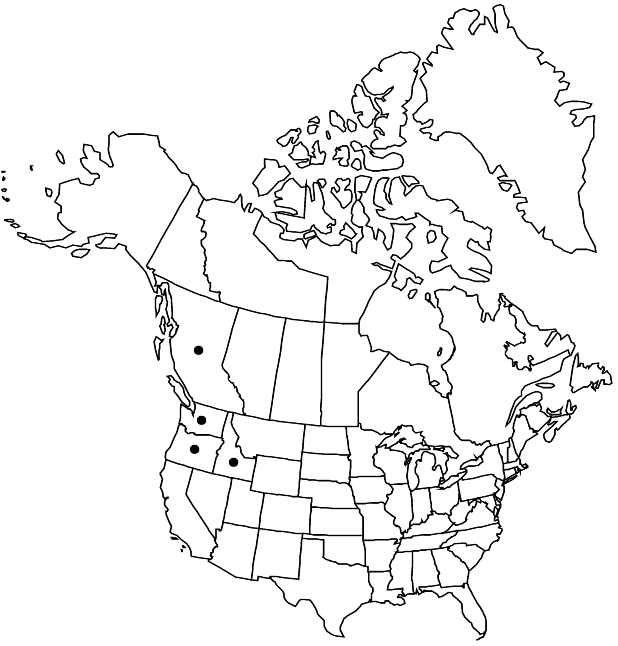Difference between revisions of "Ribes acerifolium"
Erythea 3: 34. 1895 ,.
FNA>Volume Importer |
imported>Volume Importer |
||
| (6 intermediate revisions by 2 users not shown) | |||
| Line 7: | Line 7: | ||
}} | }} | ||
|common_names=Maple-leaved currant | |common_names=Maple-leaved currant | ||
| + | |special_status={{Treatment/ID/Special_status | ||
| + | |code=E | ||
| + | |label=Endemic | ||
| + | }} | ||
|basionyms= | |basionyms= | ||
|synonyms= | |synonyms= | ||
| Line 23: | Line 27: | ||
|elevation=900-2200 m | |elevation=900-2200 m | ||
|distribution=B.C.;Idaho;Oreg.;Wash. | |distribution=B.C.;Idaho;Oreg.;Wash. | ||
| − | |discussion=<p>Ribes acerifolium K. Koch (1869), which was believed to block the use of R. acerifolium Howell, was not validly published. Consequently, the name R. howellii Greene, proposed as a substitute name, is superfluous; it appears in many floras and on many herbarium specimens.</p> | + | |discussion=<p><i>Ribes acerifolium</i> K. Koch (1869), which was believed to block the use of <i>R. acerifolium</i> Howell, was not validly published. Consequently, the name R. howellii Greene, proposed as a substitute name, is superfluous; it appears in many floras and on many herbarium specimens.</p> |
|tables= | |tables= | ||
|references= | |references= | ||
| Line 32: | Line 36: | ||
-->{{#Taxon: | -->{{#Taxon: | ||
name=Ribes acerifolium | name=Ribes acerifolium | ||
| − | |||
|authority=Howell | |authority=Howell | ||
|rank=species | |rank=species | ||
| Line 46: | Line 49: | ||
|publication title=Erythea | |publication title=Erythea | ||
|publication year= | |publication year= | ||
| − | |special status= | + | |special status=Endemic |
| − | |source xml=https:// | + | |source xml=https://bitbucket.org/aafc-mbb/fna-data-curation/src/2e0870ddd59836b60bcf96646a41e87ea5a5943a/coarse_grained_fna_xml/V8/V8_38.xml |
|genus=Ribes | |genus=Ribes | ||
|species=Ribes acerifolium | |species=Ribes acerifolium | ||
Latest revision as of 23:43, 5 November 2020
Plants 0.5–1 m. Stems spreading to erect, finely puberulent, often thickly sprinkled with small, nearly sessile to rather strongly stipitate glands; spines at nodes absent; prickles on internodes absent. Leaves: petiole 2–5.5 cm, pubescent, stipitate-glandular; blade orbiculate, lobed into 3 main and 2 smaller segments, cleft 1/2 to midrib, 3–8 cm, base deeply cordate, surfaces puberulent and stipitate-glandular abaxially, glabrous adaxially, lobes ovate-deltate, margins 2 times crenate-serrate, apex acute. Inflorescences pendent, 7–15-flowered racemes, 3–5 cm, axis crisped-puberulent, stipitate-glandular, flowers evenly spaced. Pedicels jointed, 2–8 mm, crisped-puberulent, stipitate-glandular; bracts lanceolate, 6–8 mm, crisped-puberulent, stipitate-glandular. Flowers: hypanthium greenish white with pinkish tinge, shallowly bowl-shaped, 1–1.5 mm, crisped-puberulent, stipitate-glandular; sepals nearly overlapping, spreading, tips usually recurved, pinkish or white streaked with pink, broadly oblong-ovate to nearly deltate-obovate, 2–3 mm; petals very slightly connate or distinct, spreading with sepals, rose-red, obovate-cuneate, (inwardly pouched and nearly keeled in center), 1–1.5 mm; nectary disc greenish or cream, raised, angled, covering ovary; stamens nearly as long as petals; filaments oblong, 1 mm, glabrous; anthers cream, oval, 0.2–0.3 mm, apex acute; ovary finely crisped-puberulent; styles connate 3/4 their lengths, 0.7–1 mm, glabrous. Berries palatability not known, gray-black, spheric, to 10 mm, slightly pubescent, sparsely glandular.
Phenology: Flowering Jun–Aug.
Habitat: Montane to alpine stream banks, meadow thickets, open ridges
Elevation: 900-2200 m
Distribution

B.C., Idaho, Oreg., Wash.
Discussion
Ribes acerifolium K. Koch (1869), which was believed to block the use of R. acerifolium Howell, was not validly published. Consequently, the name R. howellii Greene, proposed as a substitute name, is superfluous; it appears in many floras and on many herbarium specimens.
Selected References
None.